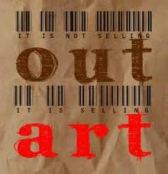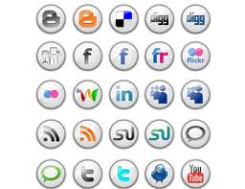Since the development of the World Wide Web, PR and online communications have become complementary parts of a functional unit. The usage of social media has therefore become a basic skill required of most PR practitioners. Unfortunately, it has of yet not become as intertwined with the cultural sector and its curators.

Even though it is clear that the internet and social media are booming businesses, the cultural sector is still characterised by a digital divide as far as public participation, knowledge sharing and communication integration go.
 As mentioned in an earlier blog post, the cultural sector still feels a bit uncomfortable using PR and social media, partly because they fear it might diminish a personal level of customer service, cause alienation, or result in a waning of the cultural offer and knowledge, making the cultural industry profit-orientated and therefore selling out the integrity and autonomy of the sector by giving the public to much influence on the displayed art. It is indeed hard to reach a diversified broad audience, while also keeping the public focused on, for example, the identity of a museum. However, social media should be seen as a tool that paints an online picture of a museum, while ensuring that the virtual and the real world both receive cohesive messages that reach the museum’s publics. Therefore, social media is not to be feared, but embraced.
As mentioned in an earlier blog post, the cultural sector still feels a bit uncomfortable using PR and social media, partly because they fear it might diminish a personal level of customer service, cause alienation, or result in a waning of the cultural offer and knowledge, making the cultural industry profit-orientated and therefore selling out the integrity and autonomy of the sector by giving the public to much influence on the displayed art. It is indeed hard to reach a diversified broad audience, while also keeping the public focused on, for example, the identity of a museum. However, social media should be seen as a tool that paints an online picture of a museum, while ensuring that the virtual and the real world both receive cohesive messages that reach the museum’s publics. Therefore, social media is not to be feared, but embraced.
The recent developments in social media, which, if I’m being honest, are quite hard to keep up with, can benefit the cultural sector in a multitude of ways. Social media can personalise a museum, gallery or excavation, if used as part of whole concept, to tell a story and place it in a certain context. Social media can become a personal voice which attracts new audiences and inspires the existing ones. An innovative Twitter campaign that proves this is the recreation of the Titanic’s Journey on Twitter.
The History Press, a publishing company focused on American heritage, commemorated the Titanic’s 100th anniversary by re-enacting its journey on Twitter. They send out real time Tweets that simulated events and the thoughts/facts of officers and crew members. Their goal was to bring historical content to the social media platform and gain continued audience engagement. The publisher also launched an iPad app with photos, biographies, and blueprints of the ship.
Social media can also be used to engage the public and increase a cultural organisation’s digital footprint. The Tweetaconda project, created by the Denver Museum of Nature & Science, certainly proves this. The idea was to feed the Tweetaconda and he would grow. The more tweets with the hashtag #tweetaconda, the longer the snake would grow, hopefully creating the world’s longest snake. The museum succeeded in driving traffic to exhibits and in increasing the Museum’s digital footprint by engaging its social media followers. Clearly Twitter is a useful platform for provide answers or information, and for sharing interesting stories.
Furthermore, social media can also serve as a new way to interact and engage with donors and volunteers. The San Diego Zoo has clearly grasped this concept, as they have proven with their ‘Make a date with your favourite animal’ project, which allowed publics to win backstage passes or adopt their favourite animals. On their Facebook page, the Zoo has been able to share interesting content, create awareness, tell audiences about the work that the Zoo does, as well as engage visitors at the park and online. It is worth mentioning that Facebook has a huge range of groups that are associated with conservation issues; these types of groups specialize in posting interesting news stories. In addition, some of them also posts information such as; job postings, internship postings, conference calls, magazine articles, free downloadable books…
Since the application of social media is still skyrocketing, utilising it creates an extra way of engaging with the public while keeping an eye on what others say about you. In the Petrie Museum of Egyptian Archaeology and in the Fenimore Art Museum, each artefact in the exhibition is accompanied by an original blog post, original comments associated with that post, and the QR code that directs users to the post itself. Visitors are encouraged to use the codes to link to the comments section and leave their own thoughts about the artefacts and the exhibition. This allows the museum to monitor the public’s sentiments concerning the museum, and provides the public with answers to their questions in a proactive way.
 After exploring these innovative ways in which museums and not-for profit organisations have adopted social media techniques and used them for their own goals, I believe that the cultural sector is slowly beginning to embrace social media, and starting to wield it in an appropriate manner. Of course, there are much more possibilities that the cultural sector needs to explore. Facebook, Twitter, Blogs, and QR codes are only the tip of the Iceberg (no pun intended). Wiki’s are also a great method of sharing information and comparing or expanding knowledge. Wikipedia hosts numerous projects to develop content, including Wikipedia Saves Public Art, which is an explicitly conservation themed project, providing a workable model for documenting works of art in the public sphere. Other media such as Podcasts, Vimeo, Instagram, YouTube, Pininterest … are also useful tools of which the application possibilities need to be explored by the cultural sector.
After exploring these innovative ways in which museums and not-for profit organisations have adopted social media techniques and used them for their own goals, I believe that the cultural sector is slowly beginning to embrace social media, and starting to wield it in an appropriate manner. Of course, there are much more possibilities that the cultural sector needs to explore. Facebook, Twitter, Blogs, and QR codes are only the tip of the Iceberg (no pun intended). Wiki’s are also a great method of sharing information and comparing or expanding knowledge. Wikipedia hosts numerous projects to develop content, including Wikipedia Saves Public Art, which is an explicitly conservation themed project, providing a workable model for documenting works of art in the public sphere. Other media such as Podcasts, Vimeo, Instagram, YouTube, Pininterest … are also useful tools of which the application possibilities need to be explored by the cultural sector.
Of course, it is of the upmost importance to remember that the services provided in the virtual world need to be of equal quality in the real world. Museums and cultural institutions need to be open, participatory, dynamic, and relevant in all places, not just online. Museums need to use the web to reach new audiences but they also need to try to convert these new audiences into real-life museum visitors, members and if possible, advocates. To accomplish this, visitors’ experiences online need to be exciting online and onsite, otherwise audiences will feel disappointed and deceived, and will not trust the institutions and their offers, therefore remaining one-time visitors. And trust is an essential requirement for building and maintaining a long-term relationship. So what does this mean for cultural institutions?
 The technological and digital divide between generations in visitors and between museum technologists, public relations practitioners and curators need to be bridged. Stereotypes and prejudices need to be conquered and interdisciplinarity and cross-industry interaction is required. I’m not saying that the mission or vision of cultural institutions need to be changed, far from it, only the way the messages and experiences are portrayed and presented needs to change and adapt to current up-to-date technology and customer expectations. I understand that it seems as an impossible problem to make the visceral as relevant, dynamic and interesting as the virtual, while also keeping up-to-date with the latest social media tools. But, it’s definitely not impossible to translate our most innovative virtual activities into onsite experiences.
The technological and digital divide between generations in visitors and between museum technologists, public relations practitioners and curators need to be bridged. Stereotypes and prejudices need to be conquered and interdisciplinarity and cross-industry interaction is required. I’m not saying that the mission or vision of cultural institutions need to be changed, far from it, only the way the messages and experiences are portrayed and presented needs to change and adapt to current up-to-date technology and customer expectations. I understand that it seems as an impossible problem to make the visceral as relevant, dynamic and interesting as the virtual, while also keeping up-to-date with the latest social media tools. But, it’s definitely not impossible to translate our most innovative virtual activities into onsite experiences.
The next blog post will look at some innovative ideas that could help the cultural sector reach its true potential and will shed some light on some futuristic ideas that might become reality sooner than you might think!
